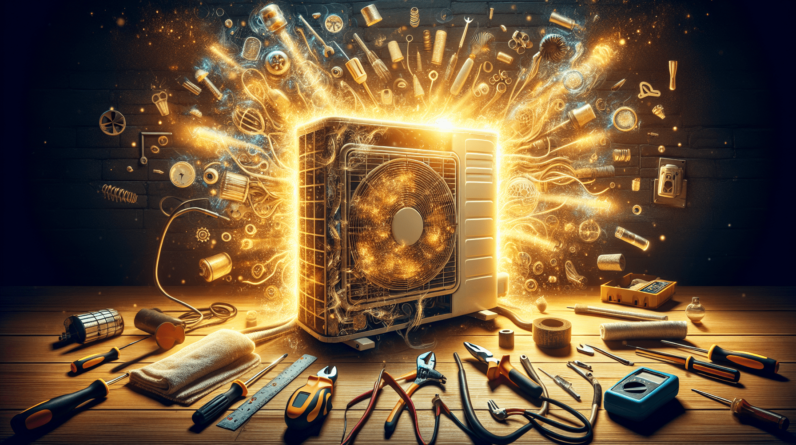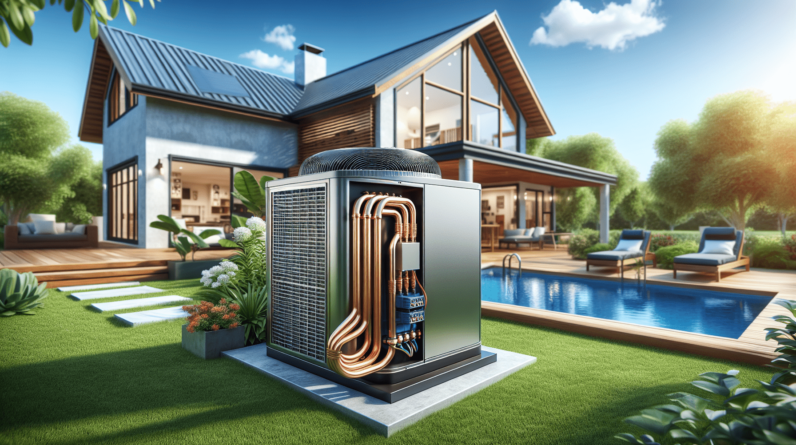
You may not give much thought to power surges, but they can pose a threat to your electrical devices and appliances. From damaging your sensitive electronics to causing fires, power surges can wreak havoc on your home. In this article, we will explore the importance of being informed about power surges and provide you with valuable tips to protect your valuable investments. Don’t wait for a power surge disaster to strike, equip yourself with the knowledge to stay prepared and safeguard your belongings.
What is a power surge?
A power surge is a sudden and brief increase in the electrical voltage that flows through your home’s electrical system. These surges can last for just a fraction of a second, but they can cause significant damage to your electronic devices and appliances. Power surges can occur for various reasons, such as lightning strikes, utility grid issues, or electrical equipment malfunctions.
Causes of power surges
Lightning strikes
One of the most common causes of power surges is lightning strikes. When lightning strikes either directly hits your home or strikes nearby power lines or utility equipment, it can send a massive surge of electricity through the electrical system. Even if the lightning strikes some distance away, the sudden changes in the electric fields can still induce power surges through the utility lines, affecting your home.
Utility grid issues
Issues within the utility grid itself can also lead to power surges. Problems such as malfunctioning transformers, downed power lines, or sudden shifts in the power demand can cause voltage spikes. These spikes can then travel to your home and potentially damage your electronic devices and appliances.
Electrical equipment malfunctions
Electrical equipment in your home, such as air conditioners, refrigerators, or even faulty wiring, can also cause power surges. When these devices experience a sudden malfunction, it can generate high electrical currents that disrupt the normal flow of electricity. These surges can travel through the circuit and affect other devices connected to the same electrical network.
How power surges affect electronic devices
Voltage spikes
Power surges, especially the ones caused by lightning strikes or utility grid issues, can result in voltage spikes. These spikes can exceed the normal operating voltage range of your electronic devices, leading to their malfunction or failure. The sudden surge of electrical energy can overwhelm the internal components, causing them to be permanently damaged.
Overheating
Another way power surges can affect your electronic devices is through overheating. When a surge occurs, the excess electricity can cause increased heat in the device’s circuitry. If the heat generated exceeds the device’s capacity to dissipate it, the components can become damaged, resulting in reduced performance or even complete failure.
Temporary or permanent damage
Power surges can cause both temporary and permanent damage to your electronic devices. In some cases, a surge may only affect the device temporarily, resulting in glitches, system crashes, or temporary power loss. However, if the surge is severe enough, it can cause irreversible damage, rendering the device completely useless or requiring expensive repairs.
Signs of power surges
Flickering lights
One of the most noticeable signs of power surges is flickering lights. If you frequently experience sudden dimming or brightening of lights, it could indicate that there are power surges occurring in your home’s electrical system. While occasional flickering may not be a cause for concern, persistent and frequent occurrences should be investigated further.
Tripped circuit breakers
If your circuit breakers constantly trip for no apparent reason, it could be a sign of power surges. Power surges can overload the electrical circuits, causing the circuit breakers to automatically shut off the flow of electricity. If you find yourself frequently resetting tripped breakers, it’s important to identify and address the underlying cause.
Burning smell
A burning smell coming from your outlets, appliances, or electrical panels can indicate power surges. When electrical components are exposed to power surges, they can overheat and even become scorched. If you notice a burning smell, it’s crucial to turn off the affected circuit immediately and have a professional inspect the electrical system to prevent potential fire hazards.
Malfunctioning or damaged appliances
If your appliances suddenly stop working or exhibit erratic behavior, it could be a result of power surges. Power surges can damage the internal circuitry of appliances, causing them to malfunction or fail altogether. If multiple devices in your home are experiencing issues simultaneously, it’s highly likely that power surges are the culprit.
Protecting against power surges
Unplugging devices during storms
To protect your electronic devices during thunderstorms or other instances where power surges may occur, it is advisable to unplug them from the electrical outlets. By disconnecting your devices from the power source, you eliminate the risk of power surges damaging them. This simple precautionary measure can save you from potential losses and the hassle of repairing or replacing your valuable electronics.
Using surge protectors
One of the most effective ways to safeguard your electronic devices is to use surge protectors. Surge protectors are devices that provide a barrier between your devices and the incoming electrical supply. They work by diverting the excess voltage from power surges, preventing it from reaching your devices. It’s important to note that surge protectors have a limited lifespan and should be replaced periodically.
Installing a whole-house surge protector
For enhanced protection against power surges, consider installing a whole-house surge protector. Unlike individual surge protectors, which only protect the devices plugged into them, whole-house surge protectors defend your entire electrical system. These protectors are typically installed at the main electrical panel of your home and can provide protection against both internal and external power surges.
Regular maintenance and inspections
Regular maintenance and inspections of your electrical system can help identify potential issues that could lead to power surges. By having a licensed electrician assess the condition of your wiring, outlets, and electrical panels, you can address any problems before they escalate. This proactive approach can significantly reduce the risk of power surges and their potential damage.
Surge protection for sensitive electronics
Uninterruptible Power Supply (UPS)
Sensitive electronic devices, such as computers, servers, and data storage systems, require an additional layer of protection. An Uninterruptible Power Supply (UPS) provides both surge protection and battery backup. In the event of a power surge or outage, the UPS seamlessly switches to battery power, allowing you to safely shut down your devices to prevent data loss or system damage.
Isolating equipment with dedicated circuits
Isolating sensitive equipment with dedicated circuits can minimize the risk of power surges. By connecting critical electronics, such as home theater systems or high-end audio equipment, to separate circuits, you reduce the likelihood of power surges caused by other appliances or devices in your home. This isolation provides an added layer of protection for your valuable and sensitive electronics.
Power conditioner
Power conditioners are another option for surge protection, particularly for audio and video equipment. They not only protect against power surges but also filter out electrical noise and stabilize voltage levels. Power conditioners are especially beneficial in areas with unreliable power quality, as they ensure a stable and clean power supply to your sensitive electronics.

The importance of surge protectors
How surge protectors work
Surge protectors work by diverting excess electrical voltage from power surges to the grounding wire. Inside surge protectors, there are metal oxide varistors (MOVs) or gas discharge tubes that detect and absorb the surge energy. By shunting the excess voltage away from your devices, surge protectors help prevent damage and provide a line of defense against power surges.
Types of surge protectors
There are various types of surge protectors available to suit different needs. Basic surge protectors provide a decent level of protection for everyday devices and appliances. However, for more sensitive electronics, such as computers or entertainment systems, it is advisable to invest in higher-quality surge protectors that offer increased joule ratings and additional safety features.
Choosing the right surge protector
When selecting a surge protector, it’s essential to consider factors such as the number of outlets needed, joule rating, clamping voltage, and response time. The joule rating indicates the surge protector’s ability to absorb energy, while the clamping voltage determines when it starts diverting the excess voltage. A lower clamping voltage and faster response time provide better protection. Additionally, it’s crucial to choose surge protectors from reputable brands that adhere to safety standards.
When to seek professional help
Frequent power surges
If you experience frequent power surges in your home, despite using surge protectors and taking preventive measures, it may be necessary to seek professional help. Electricians can assess your electrical system and identify the underlying cause of the frequent surges, whether it’s faulty wiring, issues with the utility provider, or other external factors. They can then implement solutions to mitigate the surges and protect your devices.
Repeated equipment damage
If your electronic devices consistently suffer damage or fail due to power surges, it’s a clear sign that there is an underlying issue that needs professional attention. An electrician can investigate the reasons behind the repeated equipment damage, perform necessary repairs, and recommend additional surge protection measures to safeguard your valuable devices.
Electrical system repairs
In cases where power surges have caused damage to your electrical system itself, it’s crucial to seek professional assistance for repairs. Rewiring or replacing damaged components can ensure the safety and proper functioning of your electrical system. Attempting to fix electrical issues without the necessary knowledge and expertise can lead to further damage or even electrical hazards.
Insurance coverage for power surge damage
Power surge damage is typically covered by homeowners or renters insurance policies. However, it’s essential to review your policy carefully and understand the extent of coverage. Some insurance policies may have specific exclusions or limitations when it comes to power surge-related claims. It’s a good idea to consult with your insurance provider to ensure you have adequate coverage and understand the claims process in case of damage.
Conclusion
Power surges can pose a significant risk to electronic devices and appliances in your home. Understanding the causes, effects, and signs of power surges is essential for protecting your valuable investments. By implementing preventive measures such as using surge protectors, unplugging devices during storms, and installing whole-house surge protectors, you can minimize the risk of damage and ensure the longevity of your electronic equipment. If you experience frequent surges or repeated equipment failures, it’s important to seek professional help to identify and address any underlying issues. Remember to review your insurance coverage to ensure you have adequate protection for power surge damage. With proper precautions and awareness, you can safeguard your electronic devices and enjoy peace of mind knowing they are protected against power surges.






